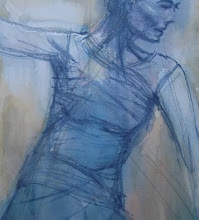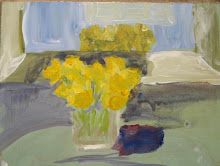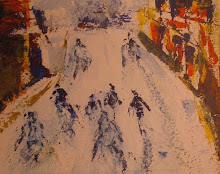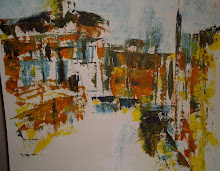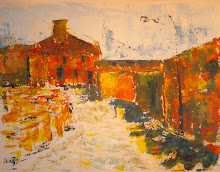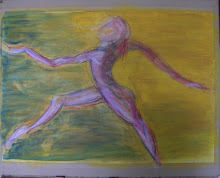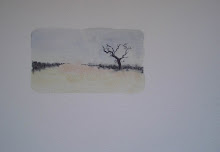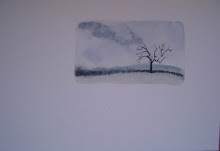Saturday 29 March 2008
Week 4 Drawing landscapes
Now I understand that in this kind and gentle group it is not that everyone is negative but that I heard the one voice that is. This particular woman uses the word ‘terrified’ about herself when confronted with a picture to draw. Her fear comes out as negativity. Other times the fear comes out as ‘should have’ – look at the others, I should have done it like that. And I suppose one of the things we learn as our own art develops is that there is less ‘should’ here than in most other aspects of life. The glorious freedom to see what happens. I wish that for the terrified woman.
Despite the ‘glorious freedom’, when I try to draw, in 2 minutes, from a photo of trees alongside a stream, I get frustrated; it feels so dead, so nothing. It is nothing – I have not been to this place, heard the stream or the wind in the branches, watched the colours change in the stream.
I have more success with an old black and white photo of snow around a pond. There are so many ponds in this area – perhaps the geology encourages ponds to form? Quick sketch – 5 minutes seems so long after 2 minutes. Sometimes the quick sketch says more than a detailed lengthy drawing because there is no extended thinking, just capturing on the page what captures the attention.
When the teacher demonstrates building one sketch on top of another, she is having a drawing conversation with the page and the pencil. Interaction.
Wednesday 26 March 2008
Week 3: Wild and free
I have carpal tunnel syndrome, left wrist. That’s why the fingers go dead while I sleep, waking to heavy absent fingers and the need to turn my wrist in a particular way to restore their life. Dead fingers. They don’t feel dead, only from the outside, but heavy, so heavy, and so needy. The right is going too; I know that although the doctor does not. An operation to slit the ligament in my wrist will free the nerve and restore my hand and its ‘wasting muscle’. Such violence. And my wrist! The delicate, slim wrists that I like so much, even though the fingers are plump sausages afterwards. The pain from using my left hand travels up my arm into my neck and reflects back down into my shoulders. I have to stop typing with two hands, the duet of meaning making on the keyboard. I am rendered lame in my typing.
My
Today we were to be wild and free – how wonderful that would be. I have A3 not A4 today, bigger is wilder.
Each flower has its own line – the tulip petal echoes the tulip leaf – the shape of its line is in its DNA. I start with a daffodil, using chunky water colour pencils, really chunky – it does not please me much, the colours lie on top of each other uncomfortably, the blue and orange are blue and orange, not daffodil.
One of the women has some dying anemones, “from Mother’s Day”. The petals have twisted themselves into wonderful shapes, drying slowly like arthritic fingers. Now the colours work together, and the shapes repeat and echo and resonate: petal, leaf, stem, each curling and twisting in a similar way. The line comes from the shared chemical constituents – they curl into similar shapes as they dry out in similar ways – I made this logic up but realise that they may have the same line for many overlapping reasons: chemical, physical, biological; it doesn’t have to be DNA. They share so much.
Friday 21 March 2008
Art and loss
Art is what we try to retrieve from the endless experience of losing.
We lose our childhoods and don’t mind too much because we feel we are moving to a better place; we see only gain. We lose our mothers, our childhood carefree moments, the summers, the endless time, we lose our fearlessness, which is not the same as gaining fear.
Tuesday 18 March 2008
Week 2: Drawing flowers
The women show each other the pictures in their sketch books, they are shy but they know they like what they have done; they even perhaps think it is quite good and want their neighbour to admire it. The women nurse each other’s sensibilities; tend to each other; make each other feel valued. The teacher’s mother, who is in the class, has a kind, open face. She notices that I am leaving and says goodbye. She notices what people need or what she thinks they need. Her attention is outwards. Does this mean that attending to the page is difficult because unfamiliar? Each woman tends to the other’s need not to feel bad; one way they do this is to down play their own work. I catch myself doing it “This bit is a mess; I haven’t got that line”, But I can see that it’s OK. And I know that drawing is forgiving – after close looking at the object we are drawing, we know how it falls short, but a new viewer has not looked as we have. They see something that we have drawn, not that we have tried to represent; our efforts are hidden from them.
How would it be if we all said positive things – I’m pleased with the way I captured this. I like the way that curve just came out right; I love the way the colour went on; I amazed myself that I drew something that looks like a cyclamen.
The town is full of old people, with sticks and little bags, walking slowly but greeting each other in one-sided conversations that the deaf other cannot quite join in. It makes me feel sad – selfishly sad because I am going to be like that; if I am lucky, and do not die or get ill, I will be like that. Alone, old, hobbling, with a small focus a limited horizon.
On the way home, Tesco had reduced the price of flowers – I buy orange tulips and discover they come with a piece of scented white broom; and daffodils, two bunches for 30p! I put them in jugs and vases all around the house.
The next search will be for flower pictures – the teacher said that my edges were too hard and I kind of understood. I want to see how others have drawn soft edges – I know, Elizabeth Blackadder. And then I will paint the tulips. Already I want to paint. And the excuse that I haven’t a studio because there is a bed in the spare room has dissolved; there is space for my easel in the kitchen between the fireplace and the window. The light is good, and there is music and coffee. Does a life need more than this?
Sunday 16 March 2008
a course, and Giacometti
... looking back at the age of 63, the entire array (of work) represents so many fumbling steps along a road to total defeat. "What I've been trying to do all my life can't be done." he says with the self-mocking grin of a man admitting a ridiculous weakness. "I want to copy reality exactly as I see it. Impossible, of course, because what you see continuously changes in time and space, non? You would need absolute knowledge, and who can attain that, hein? Nobody only an imbecile would persist, non?"
And in the same month, in the Weekend Telegraph (strange to think that I was 13 then and probably ignored that article..), Giacometti's feeling about his art:
...a losing race to trap the sensation he feels at each sight of a subject ...
I sat and sketched one of his sculptures, of a woman sitting cross-legged like a buddha. I noted "the planes of faces turned into little slabs of clay... and there are angles that produce, not longing, but poignancy, the deep sadness of being human..." Looking at one of the tall thin scupltures of a man: "remember there is a rod of iron running through the core from head to foot." And what I notice reflects how I feel, alone in Paris: poignancy, the rod of iron, the losing race.
Art courses - My 'favourites' list on Explorer includes several art courses that I go to and ponder in the evenings and weekends. This is the first one I have booked, and the first branching-out venture in my second art era. Usually it is the cost that holds me back from booking, or rather the idea that a large sum of money might only land me trapped with a class I don't want to be in for a whole two days. Not very adventurous, but I remember running from an evening class once when the atmosphere was so clogged, boring, heavy that I knew I would learn nothing. I also remember an Easter course at the Slade where I was both inspired and felt desperate; probably it was too much too soon. But my drawing leapt several years in the course of the week.
Meanwhile, I have started another old master copy, this time of a landscape with buildings, trees and people. How can it be so hard to transfer the placing of these from one rectangle (the card) to another, slightly larger, rectangle (the page of my sketch book)? Is it because I name the shapes and they become something other than shapes, occupying space as suits their name rather than their shape? My eye connecting into parts of my mind that mislead and divert attention.
Friday 14 March 2008
after the first drawing class
In the book on Rembrandt’s dry point etching – Aristotle and “art meets chance and chance meets art” is exactly the contingency idea I put into my talk to teachers about being creative several years ago. How did he do those trees?
On the drive home I notice a tree, each branch as if blown sideways, and each smaller branch off that one. The trees without leaves are themselves, unadorned, harshly skeletal.
At home during the week, I draw my pond, and in the picture the trees take all the view, but when I look I see the water. It really is dynamic and impossible to capture with a pencil.
I spend hours on the drawing, breaking off and leaving it then returning to add some more. The window panes create a handy grid that lets me construct the picture in 12 segments joined together. Still, however, the pond comes out too small. And there is no birdsong in a picture.
These limitations frustrate and may stop us doing the bit we can do. But what we learn from art is that sometimes the bit is just enough to conjure the whole.
I discover that I can still in fact draw; that I can see tone and shade, I can turn shapes into lines and curves in 2 dimensions to play that double trick between the present in the real and the absent on the page.
Thursday 13 March 2008
Week 1: Going to a drawing class
not being able to find the book (Marion Milner "On not being able to paint", I think) that might have rescued me from the absence of art in my life.
“we have decided you’re too good”
this is inescapably about me as about the art
I thought that I could not get back to my art because I know enough to know that I am not good enough. It is more complicated.
Other friends have the same problem – they can do a bit, they go to lessons for a while, and then they stop. Like dieting; like the gym?? Or just only like art.
Will I be sidelined again like the four year old? – we have decided we don’t like you. But these women – all women in the class except for one man – are not four year olds, they are sixty plus some seventy plus. And they care, or seem to..
why do they want to complain? to be negative? do they really hate what they draw? I don’t think so
In the first class, we choose an old master postcard to copy. I pick a group of people arranged nearly symmetrically with some building behind; there is a man in breeches and jacket with curls spiralling out of his head, and then women standing around gesturing and dressed in flowing classical garments, Later I turn over the card and find it is the wise and foolish virgins. But what I notice as I draw is that each person holds something – a vase or a hanging fruit basket; they hold it close to but not touching their bodies, creating a negative space that is a pleasure to draw.
The feel of pencils and erasers, the smell of sharpening a pencil, the wood and graphite warmth.
This is not too challenging. I have my sketch book – started in 2004 when the world was different, with pages marked in stiff desperation to know I could still make a mark of some sort.
As I draw I gradually invoke the old techniques – the outlining of a negative space, capturing a curve by drawing on the page while looking at the source – eye tracing; rubbing into the picture, rubbing out and adding much fainter The rubbing out creates a mess on the page, strange patches of shading and white that offer me a place to put new marks and a way to arrange those marks. This is what I love, the chanced mark that miraculously becomes an eye – it says “eye” to the viewer. The conspiracy of art.
I am not blasting back to art but tiptoeing, delicately pushing my pencil to re-inhabit old skills.
As ever, time passes unnoticed. Nothing hurts like it does when I type; my neck relaxes.
